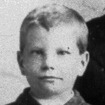Quite a Tale
In sixteenth-century France, in the village of Artigat in the region of Languedoc during the reign of François I, a boy who does not acclimate well to his peers, his community, his work, or the idea of marriage deserts his young bride and both of their families after his father accuses him of theft, only to return many  years later to claim what he thinks is rightfully his. Then, of course, problems ensue. Who is this person? Is he really who he says he is? Some say he strongly resembles one Arnaud du Tilh. His deserted wife is only too happy to have him back, and although his parents have both died and cannot verify his identity, others can, including his uncle, who for a time seems to accept and forgive him for what he has done. The story is both legendary (different versions and divergent details depending on the teller) as well as based on actual events (court transcript, official legal records). The academic account by Natalie Zemon Davis is a classic of its kind and is eminently useful for any student of the early modern period. How did a community define itself or react to a stranger? What was a family? What did privacy mean? If someone identified herself as a certain person, did it necessarily follow that others would accept the conception of the self that she had constructed? Would a woman who knew perfectly well that the man in her bed was not her husband be complicit in the ruse? If so, why?
years later to claim what he thinks is rightfully his. Then, of course, problems ensue. Who is this person? Is he really who he says he is? Some say he strongly resembles one Arnaud du Tilh. His deserted wife is only too happy to have him back, and although his parents have both died and cannot verify his identity, others can, including his uncle, who for a time seems to accept and forgive him for what he has done. The story is both legendary (different versions and divergent details depending on the teller) as well as based on actual events (court transcript, official legal records). The academic account by Natalie Zemon Davis is a classic of its kind and is eminently useful for any student of the early modern period. How did a community define itself or react to a stranger? What was a family? What did privacy mean? If someone identified herself as a certain person, did it necessarily follow that others would accept the conception of the self that she had constructed? Would a woman who knew perfectly well that the man in her bed was not her husband be complicit in the ruse? If so, why?
Camera’s Eye
The film by Daniel Vigne is probably the most realistic and believable evocation of an early modern European village that one could possibly make. Its piety and paganism intersect at numerous points: the attempted cure for Martin’s inexplicable and catastrophic wedding-night impotence by the wise-woman and the priest; his trial; and, less noticeably, the musical score by Michel Portal, deliberately primitive, especially in the use of percussion. Vigne collaborates beautifully with the actors so that the aesthetic and tone of the story are never violated. He positions us as observers, as if each viewer were a villager who is not necessarily privy to any more information than the characters are, although the camera’s  eye turns away at appropriate points (e.g., marital reunion of the long-separated couple). Although the audience is naturally supposed to sympathize with the protagonist, played by Gérard Depardieu (I have always thought of him as the French Gene Hackman), Vigne is fairminded enough to give equal weight to the viewpoint of the uncle and his family, who certainly do not want to turn over their property or assets to a hustler. The director also displays a curious sympathy for the interrogators who come to Aritgat to get to the bottom of the controversy, especially Jean de Coras, whose Arrest Memorable (1561) was the first real account of the case, and, after converting to Protestantism the next year, was later murdered in prison during the St. Bartholomew’s Day Massacre (1572). However, the center of the film seems to be Bertrande de Rols, Martin’s wife, played subtly and guilelessly by Nathalie Baye.
eye turns away at appropriate points (e.g., marital reunion of the long-separated couple). Although the audience is naturally supposed to sympathize with the protagonist, played by Gérard Depardieu (I have always thought of him as the French Gene Hackman), Vigne is fairminded enough to give equal weight to the viewpoint of the uncle and his family, who certainly do not want to turn over their property or assets to a hustler. The director also displays a curious sympathy for the interrogators who come to Aritgat to get to the bottom of the controversy, especially Jean de Coras, whose Arrest Memorable (1561) was the first real account of the case, and, after converting to Protestantism the next year, was later murdered in prison during the St. Bartholomew’s Day Massacre (1572). However, the center of the film seems to be Bertrande de Rols, Martin’s wife, played subtly and guilelessly by Nathalie Baye.
Here is a fine web page from the U.K. on the film.
 Le Retour de Martin Guerre (1982)
Le Retour de Martin Guerre (1982)